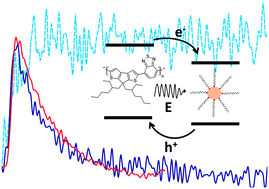Opto-electronics of PbS quantum dot and narrow bandgap polymer blends†
Abstract
Here we report on the interaction between the narrow bandgap polymer [2,6-(4,4-bis(2-ethylhexyl)-4H-cyclopenta-[2,1-b;3,4-b]dithiophene)-alt-4,7-(2,1,3-benzothiadiazole)] (PCPDTBT) and lead sulphide (PbS) colloidal quantum dots (CQDs) upon photoexcitation. We show that the presence of both materials in a blend leads to a significant reduction of photoluminescence (PL) lifetime of the polymer. This observation is attributed, supported by transient absorption (TA) data, to an efficient electron transfer towards the QDs for excitons generated on the polymer. Furthermore, the ligand capping the QD surface exhibits a great impact on the dynamics of the PL, with the long-chain oleic acid (OA) largely suppressing any kind of interaction. By means of external quantum efficiency (EQE) measurements we find evidence that both components give rise to a contribution to the photocurrent, making this an interesting blend for future applications in hybrid organic–inorganic solar cells.


 Please wait while we load your content...
Please wait while we load your content...